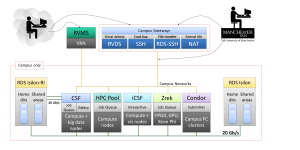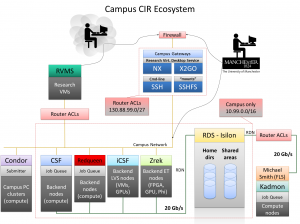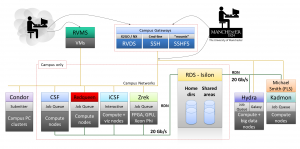An Integrated Ecosystem
Ecosystem Integration
The components of the ecosystem are integrated to make using the systems with your data as easy as possible. Many research groups have access to multiple systems in the ecosystem, for example so that both batch and interactive computation can be used to process datasets, with all systems accessing the same storage.

Components of the UoM Campus CIR Ecosystem (Click for larger image.)
- Common Storage
- Each user has the same home-directory (sees the same files) on all computational facilities — RDS-based shared areas (e.g.,
/mnt/group01-home01on the CSF) are also available everywhere within the ecosystem. - Fast, Dedicated Networking
- RDS storage, the CSF, Redqueen and Incline are all linked by a dedicated, fast network. This Research Data Network (RDN) has been extended to the Michael Smith Building to join with FLS computational infrastructure. And a major project to upgrade the campus network speed is well underway, with five buildings to be upgraded from 1 Gb to 10 Gb uplinks in 2014.
- Common Off-Campus Access — Virtual Desktop
- All ecosystem computational facilities and storage are directly accessible from on campus only (for security reasons). Methods for indirect off-campus access are therefore provided: an SFTP/SSHFS gateway to the RDS shares mounted on the compute platforms and some desktops; and a virtual desktop service, by means of which the same desktop session can be used from office, home and elsewhere.
- Integrated Web Services and Other Virtual Machines
- Increasingly, computational services are used through a Web-based front end; research output is also made available by the same means. By using the RVMS (see above), researchers are able to set up IT Services-hosted Web sites for both of these purposes.


